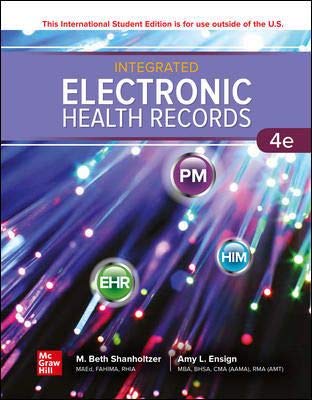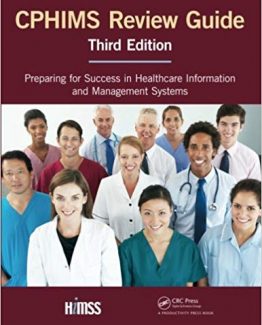Integrated Electronic Health Records INTERNATIONAL 4th Edition by M. Beth Shanholtzer, ISBN-13: 978-1260575200
[PDF eBook eTextbook]
- Publisher: McGraw Hill; 4th INTERNATIONAL edition (June 11, 2020)
- Language: English
- ISBN-10: 1260575209
- ISBN-13: 978-1260575200
Developed as a comprehensive learning resource, this hands-on course for Integrated Electronic Health Records is offered through McGraw Hill’s Connect. Connect uses the latest technology and learning techniques to better connect professors to their students, and students to the information and customized resources they need to master a subject. Both the worktext and the online course include coverage of EHRclinic, an education-based EHR solution for online electronic health records, practice management applications, and interoperable physician-based functionality. EHRclinic will be used to demonstrate the key applications of electronic health records. Attention is paid to providing the “why”behind each task, so that the reader can accumulate transferable skills. The coverage is focused on using an EHR program in a doctor’s office, while providing additional information on how tasks might also be completed in a hospital setting.
Table of Contents:
Title Page
Copyright Page
Brief Contents
Contents
Preface
Connect Page
Walkthrough of EHRclinic Exercises in Connect
About the Authors
Acknowledgments
Chapter 1 An Overview of EHRclinic’s Practice Management and Electronic Health Record Software
1.1 Practice Management Applications
1.2 Why Adopt Electronic Health Record Applications?
1.3 Electronic Health Record Applications
1.4 The Flow of Information from Registration through Processing of the Claim
1.5 Use of the Help Feature
Chapter 2 Health Data Structure, Collection, and Standards
2.1 The Professionals Who Maintain and Use Health Information
2.2 Data versus Information
2.3 Information Governance
2.4 Computer-Based Health Information Media
2.5 Screen-Based Data Collection Tools
2.6 Collecting Data Elements
2.7 Electronic Health (Medical) Records (EHRs) (EMRs)
2.8 Laws, Regulations, and Standards
2.9 Similarities and Differences between a Physician’s Office and Hospital Information Systems
Chapter 3 Content of the Health Record—Administrative Data
3.1 Administrative Data Elements
3.2 Administrative Uses of Data
3.3 Accountable Care
3.4 The Master Patient (Person) Index (MPI)
3.5 Registering a New Patient in EHRclinic
3.6 Scheduling an Appointment
3.7 Editing Demographic Data
3.8 Checking In a Patient
3.9 Capturing Insurance Information
3.10 Guiding Staff Through the Use of an Electronic System
Chapter 4 Content of the Health Record—The Past Medical, Surgical, Family, and Social Histories
4.1 Forms as Data Collection Tools
4.2 The Past Medical, Surgical, Family, and Social Histories
4.3 Handling Inconsistent or Unclear Information
4.4 Documenting Vital Signs
Chapter 5 Content of the Health Record—The Care Provider’s Responsibility
5.1 The SOAP Note
5.2 The History of Present Illness (HPI)
5.3 The Review of Systems (ROS)
5.4 The Physical Exam
5.5 Medical Dictation and Transcription
5.6 Voice and Speech Recognition Technologies
5.7 Electronic Prescribing (ePrescribing)
5.8 Computerized Physician Order Entry (CPOE)
5.9 Tracking Physicians’ Orders
5.10 The Problem List
Chapter 6 Financial Management: Insurance and Billing Functions
6.1 Claims Management—Why and How
6.2 Use of an Encounter Form
6.3 The Claims Process Using EHRclinic
6.4 Diagnosis and Procedure Coding Using EHRclinic
6.5 The Relationship between Documentation and Coding
6.6 Accountable Care Organizations
6.7 Accounts Receivable—Getting Paid
6.8 Managing Accounts Receivable in EHRclinic
6.9 Compliance
Chapter 7 Privacy, Security, Confidentiality, and Legal Issues
7.1 The HIPAA Privacy and Security Standards
7.2 Evaluating an EHR System for HIPAA Compliance
7.3 The Role of Certification in EHR Implementation
7.4 Applying Security Measures
7.5 Handling Sensitive and Restricted Access
7.6 Data Integrity
7.7 Apply Policies and Procedures to Release Health Information Using EHRclinic
7.8 Accounting of Information Disclosures
7.9 Information Exchange
7.10 Compliance Plans
7.11 Safeguarding Your System and Disaster Recovery Planning
Chapter 8 Management of Information and Communication
8.1 Internal Communications
8.2 Importing Documents to the EHR
8.3 Master Files and Templates
8.4 Customization
8.5 Using Software to Organize Your Work—Task Lists
8.6 Using Software as a Reminder
Chapter 9 Promoting Interoperability and Compliance Support
9.1 Using the Dashboard in EHRclinic to Meet Meaningful Use Standards
9.2 Data and Information Used in Decision Support
9.3 Use of Report-Writer for System Reports
9.4 Custom Report Writing
9.5 Uses of Indexes
9.6 Uses of Registries
9.7 The Credentialing Process
Chapter 10 Looking Ahead—The Future of Health Information and Informatics
10.1 Health Information versus Health Informatics
10.2 Initial Adoptions of Electronic Health Records
10.3 Ancillary Technologies
10.4 Making the World of Health Informatics User-Friendly and Convenient
10.5 Virtual Private Networks—Advancing the Use of EHRs Remotely Yet Securely
Chapter 11 Additional Practice
Chapter 11 Exercises
Source Documents
appendix
Glossary
Index
M. Beth Shanholtzer, MAEd, RHIA, FAHIMA , has been in the health information management field for 35 years. Her experience includes HIM department management positions within hospitals in New Jersey, Pennsylvania, West Virginia, and Maryland. She has been in academics for 20 years, and she is currently the program director and an assistant professor for an HIM associate degree program at Lord Fairfax Community College in Middletown, Virginia. She previously held positions as program director and instructor of associate degree programs at Kaplan University. She is an active AHIMA member, serving on the Council for Excellence in Education (CEE) board, and is currently chairperson of the Faculty Development Workgroup of the CEE. She also serves as a student mentor. On thestate level, Beth has served as president, education chair, and legislative chair of the West Virginia Health Information Management Association. She has presented at the AHIMA annual convention, the Assembly on Education (AOE), and WVHIMA conferences. In recognition of her experience as a practitioner and her advancement of the field of health information, Beth has earned the distinction of Fellow of the American Health Information Management Association (FAHIMA). Beth has authored and co-authored the first and second editions of Integrated Electronic Health Records: A Worktext for Greenway Medical Technologies’ PrimeSUITE, published by McGraw-Hill Education. Beth lives in Martinsburg, West Virginia, with her husband; they have three children.
Amy Ensign, MBA, BHSA, CMA (AAMA), RMA (AMT), has been in the medical field for over 20 years, working clinically, administratively, and in higher education. Beginning her career as a medical assistant with one of Michigan’s major healthcare organizations, she moved into a leadership role working with senior management and supervising medical assistants. Dur-ing this time, she began teaching as an adjunct instructor for Baker Col-lege and 10 years ago moved into her current position as medical assistant and medical administrative specialist program director for Baker College of Clinton Township. She is also active in the AAMA as treasurer of Michi-gan’s Macomb Chapter. Amy lives in Sterling Heights, Michigan, with her husband; they have two children.
What makes us different?
• Instant Download
• Always Competitive Pricing
• 100% Privacy
• FREE Sample Available
• 24-7 LIVE Customer Support





